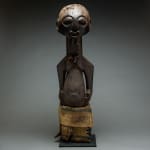Songye Wooden Sculpture of a man, 20th Century CE
Wood
76.2 x 21.6 cm
30 x 8 1/2 in
30 x 8 1/2 in
X.1033 (LSO)
Further images
This darkly-patinated sculpture of a standing man is a bishimba figure made by the Songye people of what was once Zaire. It is stylistically unusual, with a very dark colour,...
This darkly-patinated sculpture of a standing man is a bishimba figure made by the Songye people of what was once Zaire. It is stylistically unusual, with a very dark colour, unusual treatment of the facial features, the geometric reductivism of the body and the adornment with a textile “skirt” and a pendant on a raffia cord. It is a tall and well-proportioned example with a large abdomen, angularity of limbs and breasts and considerable evidence for age in terms of arrested insect damage and erosion. The colour of the wood suggests that it also received libations.
The Songye people are based in the Democratic Republic of Congo (formerly Zaire). They were founded in the 16th century following an exodus from the neighbouring Shaba area, settling near to the Lualuba River. There are around 150,000 Songye divided into subgroupings that are under the governorship of a central chief known as the Yakitenge. More local governance is in the hands of chiefs known as Sultani Ya Muti. Their economy is based upon agriculture and pastoralism.
The Songye are perhaps best known for their artworks, which are both institutional and domestic/personal in nature. Their best-known artefacts are kifwebe masks created for members of the Bwadi Bwa. The word kifwebe means “mask” in Songye, and describes long-faced creations decorated with curvilinear designs. Crested examples are male, while plain-topped ones are female; the masquerade dancers wearing each of these masks interact during masquerades to demonstrate the contrasting virtues of power (male) and familial values (female).
The most impressive figural works are wooden sculptures that are sometimes decorated with feathers and other organic materials, and which are known as Bishimba. Their magical powers are contained within the horn inserted into the top of the head, which may contain objects such as organic residues, grave earth and biological objects such as feathers or claws. The navel may also be used to situate a bilongo (packet of magical materials), similar to the Kongo tradition. The figures are often adorned with gifts in the form of furs, bells and other objects that are used to dress the figure; they also tend to receive libations, physical manifestations of appeals made for spiritual assistance.
This is an interesting and striking piece of African art.
The Songye people are based in the Democratic Republic of Congo (formerly Zaire). They were founded in the 16th century following an exodus from the neighbouring Shaba area, settling near to the Lualuba River. There are around 150,000 Songye divided into subgroupings that are under the governorship of a central chief known as the Yakitenge. More local governance is in the hands of chiefs known as Sultani Ya Muti. Their economy is based upon agriculture and pastoralism.
The Songye are perhaps best known for their artworks, which are both institutional and domestic/personal in nature. Their best-known artefacts are kifwebe masks created for members of the Bwadi Bwa. The word kifwebe means “mask” in Songye, and describes long-faced creations decorated with curvilinear designs. Crested examples are male, while plain-topped ones are female; the masquerade dancers wearing each of these masks interact during masquerades to demonstrate the contrasting virtues of power (male) and familial values (female).
The most impressive figural works are wooden sculptures that are sometimes decorated with feathers and other organic materials, and which are known as Bishimba. Their magical powers are contained within the horn inserted into the top of the head, which may contain objects such as organic residues, grave earth and biological objects such as feathers or claws. The navel may also be used to situate a bilongo (packet of magical materials), similar to the Kongo tradition. The figures are often adorned with gifts in the form of furs, bells and other objects that are used to dress the figure; they also tend to receive libations, physical manifestations of appeals made for spiritual assistance.
This is an interesting and striking piece of African art.









